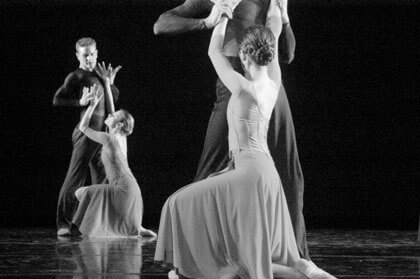BalletMet shakes off opening ragged start to prove it’s got the right stuff
By GUS SOLOMONS JR.
By the end of the program in their Joyce Theater debut May 25 through 30, BalletMet Columbus had won us over, but it got off to a shaky start.
This 25-year-old company from Ohio has a fine reputation among America’s regional ballet companies for solid, if not spectacular dancing and a relatively adventurous repertoire. Its new artistic director Gerard Charles brought us a mixed bill of three ballets, including one by Stanton Welsh, whom Gerard succeeds as artistic director, and another by Canadian James Kudelka.
The opener, “Colores de Alma,” by guest choreographer Deanna Carter from Seattle, set to an assortment of Flamenco music—not credited in the program—loses focus in a meandering structure that seeks to flatter by imitation Spain’s premier modern dance maker, Nacho Duato. Danced in soft shoes, the piece has a bland Andalusian peasant flavor—hunched lifts with the women’s feet flexed, lots of macho male lunging. Perhaps new casting or rushed rehearsals result in some ragged unisons and rhythmically vague canons. Only Jimmy Orrante and Olivia Clark’s penultimate duet sizzled.
Happily, the works that follow elevate BalletMet above the dreaded stigma of “regionalism” to national caliber. Internationally renowned Kudelka, one of the most consistently clever and inventive choreographers anywhere, hooked his wagon to John Corigliano’s “Gazebo Dances for Band.” The bright, buoyant movement of the four sections of “Gazebo Dances” fits the music like a glove. In “Overture,” five lively guys—Justin Gibbs, Patrick Howell, Derek Sakakura, Richard Tullius, and Randolph Ward—in white tunics and trousers and red suede shoes caper, skip, and leap like a five-pack of court jesters.
In “Waltz,” four men in blue shoes and four women with Raggedy Ann-striped sleeves and bouncy little bustles all clump together like a clan of adolescent puppets, exchanging partners, toppling giddily to the floor, scurrying around. Pairs exchange cautious kisses then firmly wipe off their partners’ mouths with their sleeves; the lights fade as two women pucker up together.
Throughout “Adagio,” stoic Hisham Omardien keeps a hand clapped over his mouth and sumptuous Sonia Welker covers an eye with one of hers. As their dance grows sexier and romantic passions rise, their solutions to the challenges of maintaining their speak-no-evil, see-no-evil stances are humorously tested. And “Tarantella” caps the fun with everyone cavorting in a calculated riot of activity.
Welsh, now BalletMet’s artistic associate who heads the Houston Ballet, contributed “Play,” a charming finale that uses the driving pulse of Moby’s disco-pop music to propel 14 harried urbanites through their quotidian rat race. They endlessly crisscross the stage in David Grill’s provocative grid of changing light. A sultry, bluesy men’s section has Ailey-esque overtones. The unabashed accessibility of “Play” is probably what makes BalletMet a popular Ohio treat, and the earnest, unassuming performances of its 28 dancers won New York’s heart.


































